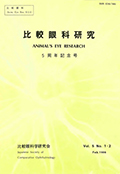Volume 5, Issue 1-2
Displaying 1-6 of 6 articles from this issue
- |<
- <
- 1
- >
- >|
Memorial Lecture at The Fifth Anniversary Meeting of Japanese Society of Comparative Ophthalmology
-
1986 Volume 5 Issue 1-2 Pages 1-14
Published: 1986
Released on J-STAGE: December 25, 2020
Download PDF (4076K)
Reports and Lecture at 5th Symposium on Some Problems in the Field of Comparative Ophthalmology
Special Lecture
-
1986 Volume 5 Issue 1-2 Pages 15-30
Published: 1986
Released on J-STAGE: December 25, 2020
Download PDF (4010K)
Reports
-
1986 Volume 5 Issue 1-2 Pages 31-40
Published: 1986
Released on J-STAGE: December 25, 2020
Download PDF (2280K) -
1986 Volume 5 Issue 1-2 Pages 41-48
Published: 1986
Released on J-STAGE: December 25, 2020
Download PDF (1909K)
Brief Note
-
1986 Volume 5 Issue 1-2 Pages 49-56
Published: 1986
Released on J-STAGE: December 25, 2020
Download PDF (1757K)
Bibliography
-
1986 Volume 5 Issue 1-2 Pages 57-87
Published: 1986
Released on J-STAGE: December 25, 2020
Download PDF (8799K)
- |<
- <
- 1
- >
- >|
